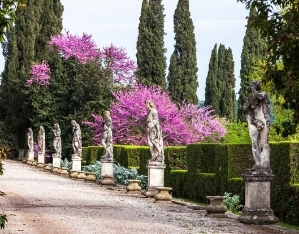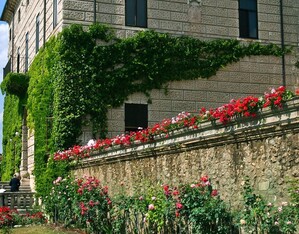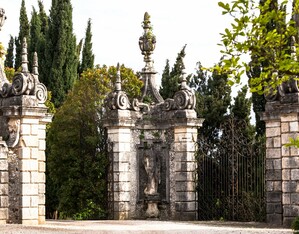“Art is such a friend of Nature here!” These were the words of Domenico Lazzarini who in the early 18th century attested the fabulous harmonisation of gardens and architecture, that paired with the scenic view of the Agno Valley, make Villa Trissino Marzotto one of the most beautiful residences of the area of Vicenza and of the whole Veneto region.
An extraordinary example of integration between landscape, villa and garden, this complex is composed of various elements forming unique views with unusual geometric visual effects on the surrounding landscape. The restoration of the residence, commissioned by Marcantonio Trissino Baston, was carried out by Francesco Muttoni, who enlarged the “Villa superiore” (upper villa) between 1718 and ‘22, while only a few years later, in 1746, Cristoforo Trissino Riale had the “Villa inferiore” (lower villa) built possibly designed by Girolamo Frigimelica. The two separate buildings were subsequently united into one single property of the Trissino Baston family. Between 1750 and 1761 Muttoni’s role was taken by Girolamo Dal Pozzo, who introduced the large “prato verde” – a vast lawn south of the property that completed the “Villa superiore” bordered at one end by the “Cavallerizza” area and on the sides by open walls with arch-windows. The layout of the large lawn terraces is of extraordinary interest. In 1841 the “Villa inferiore” was struck by lightning and destroyed; it was rebuilt in 1834 following an eclectic style of architecture and then later abandoned. The garden is laid out in large formal garden areas set inside a wood, and takes advantage of the different levels of the ground to create elevated gardens and terraces with great panoramic views. The “Viale di Limoni” (Lemon avenue) facing south, stretches from the “Villa Superiore” to the octagonal belvedere designed by Muttoni and embellished with a flower garden, already present in a 1748 graphic rendition of the area. The “Viale delle Ortensie” (Hydrangea avenue) begins at the “Villa Inferiore” and climbs up to the “camera verde” (green room) and to the belvedere with rose gardens. As well as the monumental late-Baroque entrances, the flights of steps, the over one hundred statues from the Marinali workshop, also of note are the “cedrere” (citron tree collections), a fishpond, and Neptune’s fountain facing a wood home to oaks, holm oaks, yews, cedars of Lebanon, Himalayan pines and centuries-old redwoods.




